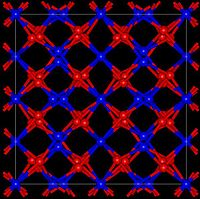- Yttrium(III) oxide
-
Yttrium(III) oxide  Yttrium(III) oxide.Other namesYttria,
Yttrium(III) oxide.Other namesYttria,
diyttrium trioxide,
yttrium sesquioxideIdentifiers CAS number 1314-36-9 
RTECS number ZG3850000 Properties Molecular formula Y2O3 Molar mass 225.81 g/mol Appearance White solid. Density 5.010 g/cm³, solid Melting point 2425 °C
Boiling point 4300 °C
Solubility in water insoluble Solubility in alcohol
acidsoluble Structure Crystal structure Cubic (bixbyite), cI80[1] Space group Ia-3, No. 206 Coordination
geometryOctahedral Hazards MSDS External MSDS EU classification None listed. R-phrases Not hazardous S-phrases S24/25 Related compounds Other cations Scandium(III) oxide,
Lanthanum(III) oxideRelated compounds Yttrium barium
copper oxideSupplementary data page Structure and
propertiesn, εr, etc. Thermodynamic
dataPhase behaviour
Solid, liquid, gasSpectral data UV, IR, NMR, MS  oxide (verify) (what is:
oxide (verify) (what is:  /
/ ?)
?)
Except where noted otherwise, data are given for materials in their standard state (at 25 °C, 100 kPa)Infobox references Yttrium oxide is Y2O3. It is an air-stable, white solid substance. Yttrium oxide is used as a common starting material for both materials science as well as inorganic compounds.
Contents
Uses
Materials science
It is the most important yttrium compound and is widely used to make YVO4 europium and Y2O3 europium phosphors that give the red color in color TV picture tubes. Yttrium oxide is also used to make yttrium iron garnets, which are very effective microwave filters.
Y2O3 is used to make the high temperature superconductor YBa2Cu3O7, known as "1-2-3" to indicate the ratio of the metal constituents:
- 2 Y2O3 + 8 BaO + 12 CuO + O2 → 4 YBa2Cu3O7
This synthesis is typically conducted at 800 °C.
The thermal conductivity of yttrium oxide is 27 W/(m·K).[2]
Inorganic synthesis
Yttrium oxide is an important starting point for inorganic compounds. For organometallic chemistry it is converted to YCl3 in a reaction with concentrated hydrochloric acid and ammonium chloride.
Lasers
Y2O3 ceramics is a prospective solid-state laser material. In particular, lasers with ytterbium as dopant allow the efficient operation both in cw operation [3] and in pulsed regimes.[4] At high concentration of excitations (of order of 1%) and poor cooling, the quenching of emission at laser frequency and avalanche broadband emission takes place.[5]
References
- ^ Yong-Nian Xu; Zhong-quan Gu; W. Y. Ching (1997). "Electronic, structural, and optical properties of crystalline yttria". Phys. Rev. B56 (23): 14993–15000. doi:10.1103/PhysRevB.56.14993.
- ^ P. H. Klein and W. J. Croft (1967). "Thermal conductivity , Diffusivity, and Expansion of Y2O3, Y3Al5O12, and LaF3 in the Range 77-300 K". J. Appl. Phys. 38 (4): 1603. doi:10.1063/1.1709730.
- ^ J. Kong; D.Y.Tang, B. Zhao, J.Lu, K.Ueda, H.Yagi and T.Yanagitani (2005). "9.2-W diode-pumped Yb:Y2O3 ceramic laser". Applied Physics Letters 86 (16): 161116. Bibcode 2005ApPhL..86p1116K. doi:10.1063/1.1914958.
- ^ M.Tokurakawa; K.Takaichi, A.Shirakawa, K.Ueda, H.Yagi, T.Yanagitani, and A.A. Kaminskii (2007). "Diode-pumped 188 fs mode-locked Yb3+:Y2O3 ceramic laser". Appl.Phys.Lett. 90 (7): 071101. Bibcode 2007ApPhL..90g1101T. doi:10.1063/1.2476385.
- ^ J.-F.Bisson; D.Kouznetsov, K.Ueda, S.T.Fredrich-Thornton, K.Petermann, G.Huber (2007). "Switching of emissivity and photoconductivity in highly doped Yb3+:Y2O3 and Lu2O3 ceramics". Appl.Phys.Lett. 90 (20): 201901. doi:10.1063/1.2739318.
External links
Yttrium compounds Categories:- Yttrium compounds
- Inorganic compounds
- Oxides
- Sesquioxides
- Inorganic compound stubs
Wikimedia Foundation. 2010.
